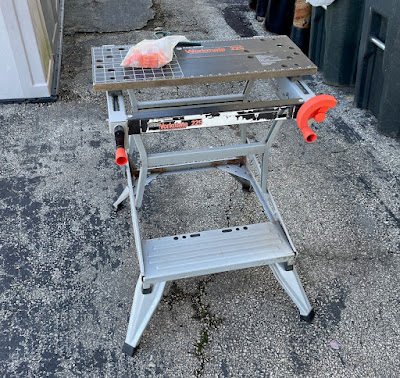Pennsylvania's early muzzleloader antlerless deer season was last week. PA was one of the first states to have a muzzleloader-only season but for decades this started the day after Christmas and was flintlock-only. That season is still available and is for antlered or antlerless deer, but the early antlerless-only season is a more recent addition. In the early season, any .44 caliber or larger muzzleloader is legal, so a lot of guys use percussion or inline rifles.
My friend N. owns about 65 acres in Tioga County, which is in north central PA, just south of NY. We went up there last week to catch the tail end of the early antlerless season.
Late Friday, he took a shot at a doe but it was a clean miss. He shot high because the sights on his rifle are difficult to see especially in the wrong light. (He has plans to fix this.)
Saturday morning we got on stand. At 8:05 AM I heard a shot from the direction where he posted up and when I got to him, saw that he'd bagged a button buck. The .440 round ball from his Euroarms Kentuckian Carbine flintlock had passed through both lungs and must have hit a major blood vessel, because the deer bled out almost immediately and collapsed after running 15 feet.
I went and got my truck while N. field dressed it. We loaded it into the back of my Xterra and took it up to the campsite where we skinned and quartered it, and put it on ice. We had that done by lunchtime.
After eating lunch, then relaxing for awhile with a Guiness and a cigar each, we headed back out to a different part of the property at about 3:00 PM (closing time was 6:49 PM). He came with me to help with dressing and dragging out a deer if I got lucky.
At about 5:40 PM I had to stand up and stretch. I noticed a doe grazing in the field in front of us, about 60 or 70 yards out. I sat back down and a second doe appeared. I signaled to N. that we had a couple deer in sight.
Both of the deer were large. There's a cornfield and a couple pear trees across the street from N.'s land so they've been feeding well.
For a few minutes I peered over the burlap blind as the deer slowly worked their way towards us. At one point both were broadside but one was behind the other and I didn't want to risk wounding it if I shot the one closest to me.
Eventually, I had a clear broadside shot presented to me and I stood up to clear the blind, placed my front sight bead behind her shoulder and touched off the shot. The .490 round ball from my Cabela's (Investarm) Hawken caplock hit right where I aimed.
Strangely, the other deer didn't immediately bolt. Rather, it stomped and snorted at us, and even advanced a little towards us before turning and running. If N. hadn't already tagged out that morning he probably could have shot this one.
As we eventually discovered, the ball didn't exit and because it was a high lung shot the blood trail was poor, but we tracked it down in about 15 minutes. We decided not to wait before tracking it because we were running short on daylight. Normally we'd wait 30 minutes to allow the deer to lay down and expire. But all's well that ends well, and we got the second deer of the day up to the campsite, skinned and quartered, and on ice.
Something we noticed on these deer was that they both had large quantities of fat reserves under their skin. I saved a gallon Ziploc bag of fat to be rendered down into deer tallow, which will make good patch lube.
N. has an extra fridge that the deer is now in. He wound up having to bone out all the meat because the legs wouldn't fit in his meat bins. With the bones and fat cut out we have over 80 pounds of meat! I'll be going over to his house next weekend to help process it.
We always try to learn lessons and do better. N. is going to put better sights on his rifle. I'm planning to experiment with heavier powder charges in my rifle to improve the chances of a complete pass through if I shoot another large deer with it. Aside from increasing the powder charger to more than 70 grains, I also have some Hornady Great Plains bullets and may try some Maxi balls.











